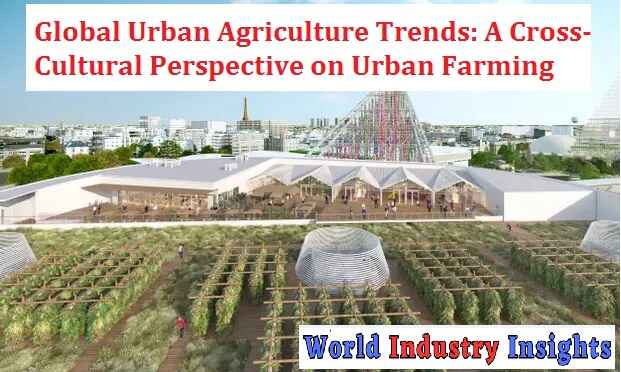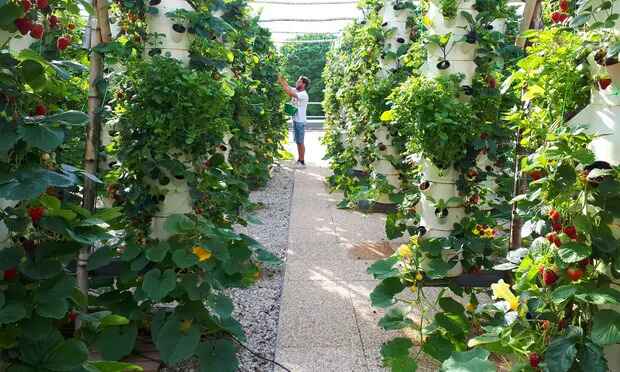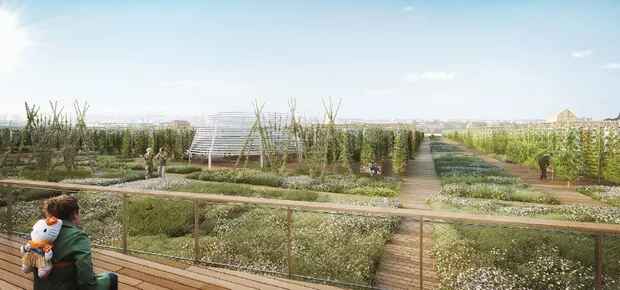Global Urban Agriculture Trends: On the international stage, a new but familiar player emerges in the sphere of sustainability urban agriculture. This practice, intertwined with the daily grind of city living, breathes fresh and novel perspectives into how we comprehend agriculture as a whole.
Understanding Urban Agriculture
Defining urban agriculture and its significance
Urban agriculture denotes the cultivation of plants, the raising of animals, and the production and distribution of food in urban areas. This practice seizes the otherwise dormant pockets of urban space, converting them into vibrant, productive green havens.
Historical roots of urban farming
Urban farming is no newcomer. The practice traces back to the ancient civilizations of Mesopotamia, Rome, and Egypt, where city-dwellers ingeniously integrated agricultural activities within urban designs. The historical tapestry of urban farming offers a compelling testament to human adaptability.
Benefits of urban agriculture
Urban agriculture brings a cornucopia of advantages, from bolstering food security, reducing food miles, creating employment opportunities, enhancing biodiversity, to improving mental wellbeing. This confluence of benefits is transforming the urban fabric, imbuing cities with resilience, vibrancy, and health.
The Rise of Urban Agriculture Worldwide
Exploring the global scale of urban farming
Agriculture is not confined to rural landscapes anymore. Today, cities from New York to Nairobi, Beijing to Berlin, are harnessing the transformative potential of urban farming, proving that agriculture is an increasingly cosmopolitan affair.
Major cities leading the way in urban agriculture
Cities like Detroit, Havana, and Tokyo are trailblazing urban agriculture, transforming from concrete jungles into green, food-producing powerhouses. These cities exemplify the robustness of urban agriculture, and their success serves as an inspiration for other urban areas globally.
Factors driving the growth of urban farming
A multitude of factors, including population growth, food security concerns, climate change, and a renewed interest in local food systems, are fueling the rise of urban agriculture. This convergence of factors has catalyzed an unprecedented expansion in urban farming practices.
Innovative Approaches to Urban Farming
Vertical Farming
Definition and principles of vertical farming
Vertical farming is a form of agriculture where crops are cultivated in vertically stacked layers, usually in controlled environments. This innovative method decouples farming from expansive farmlands and natures caprices, enabling a continuous and predictable harvest.
Advantages and challenges of vertical farming
Vertical farming can drastically increase crop yields, reduce water usage, and eliminate the need for harmful pesticides. However, it also presents challenges such as high upfront costs, energy use, and the need for specialized knowledge.
Noteworthy vertical farming projects worldwide
Groundbreaking projects, like Aero Farms in New Jersey and Sky Greens in Singapore, are illuminating the pathway to successful vertical farming, demonstrating its viability and potential to revolutionize food production.
Rooftop Gardening
Utilizing rooftops for agricultural purposes
Rooftop gardening transforms underutilized urban rooftops into vibrant horticultural spaces, allowing urbanites to grow food while improving the urban microclimate.
Benefits and considerations of rooftop gardening
Rooftop gardens can reduce urban heat island effects, improve stormwater management, and increase local food production. However, structural considerations and high establishment costs can pose barriers to implementation.
Success stories of rooftop gardens in different cities
Santropol Roulant in Montreal and Eagle Street Rooftop Farm in New York are testament to the transformative power of rooftop gardens, offering fresh produce to local communities and enhancing urban biodiversity.
Community Gardens
Creating communal spaces for urban farming
Community gardens are communal spaces where individuals can grow their food, fostering a sense of community and shared responsibility while improving urban green space.
Social and environmental benefits of community gardens
Community gardens promote social cohesion, enhance biodiversity, and provide fresh produce to local communities. They serve as urban oases, contributing to the health and wellbeing of city dwellers.
Case studies of successful community garden initiatives
Community garden initiatives such as the Incredible Edible Network in the UK and the Prinzessinnengärten in Berlin are paving the way, demonstrating how communal spaces can create sustainable, resilient urban food systems.
Indoor Farming
Harnessing technology for indoor agricultural systems
Indoor farming employs technology to cultivate plants within buildings, using controlled environments to optimize growth conditions. It can take various forms, from simple window sill herb gardens to high-tech hydroponic systems.
Advantages and limitations of indoor farming
Indoor farming offers year-round production, efficient resource use, and protection from weather extremes. However, high energy costs, expensive setup, and complex technology management can limit its broad-scale adoption.
Prominent indoor farming projects around the world
Projects like Gotham Greens in New York and Agricool in Paris stand as shining beacons of indoor farming, demonstrating that technology and nature can synergize to form productive, sustainable food systems within our urban landscape.
Cultural Perspectives on Urban Farming
Asian Urban Agriculture
Traditional practices in Asian cities
Asian urban agriculture is a potpourri of old and new. Traditional practices like kitchen gardening and community allotments are entwined with modern vertical farming and high-tech greenhouses, forming a fascinating tapestry of urban agriculture.
Modern innovations and adaptations
Innovative approaches like Japans Pasona O2 and Chinas Plant Factories with Artificial Lighting demonstrate Asias adaptability and ingenuity in harnessing technology for urban agriculture.
Case studies from Asian cities
Examples such as the Cheonggyecheon stream restoration project in Seoul and the urban farms of Hong Kong show how Asian cities are integrating agriculture into their urban fabric, thereby contributing to food security and ecological sustainability.
European Urban Agriculture
Historical context and urban farming traditions in Europe
European urban agriculture landscape is an intriguing mix of historic allotment gardens, community gardens, and innovative farming methods like aquaponics and hydroponics.
Contemporary approaches and policies
European cities are increasingly incorporating urban agriculture into policy frameworks, promoting local food production, and fostering sustainable urban development.
Examples of successful European urban farming projects
From the rooftop farms of Rotterdam to the urban vineyards of Paris, European cities are teeming with successful urban farming projects, each presenting a unique solution to the challenges of urban food production.
North American Urban Agriculture
Urban farming movements in North America
Urban farming in North America is on the rise, driven by grassroots movements, innovative startups, and supportive policies. These efforts are reshaping the urban food landscape, promoting community resilience, and sustainability.
Policy frameworks and initiatives
Various North American cities have developed comprehensive urban agriculture strategies, demonstrating a commitment to supporting local food production, job creation, and community development.
Urban farming success stories in North American cities
Urban farming success stories such as the Detroit Urban Farms and San Franciscos Alemany Farm illustrate how urban agriculture can transform cities, offering fresh food, community engagement, and ecological benefits.
African Urban Agriculture
Unique challenges and opportunities in African cities
Urban agriculture in African cities faces unique challenges, such as land tenure issues and water scarcity. However, these challenges are matched by opportunities for innovation, resilience, and community empowerment.
Indigenous agricultural practices and urban adaptations
African cities are weaving a unique blend of traditional knowledge and urban adaptations, creating dynamic, resilient urban food systems that reflect the continent’s rich cultural diversity.
Promising examples of urban farming in African contexts
From the micro-gardens of Dakar to the urban farms of Nairobi, Africa’s cities are bustling with innovative urban agriculture initiatives, offering lessons in resilience, resourcefulness, and sustainability.
Sustainability and Resilience in Urban Agriculture
Environmental considerations of urban farming
Urban farming is not without environmental considerations, from soil health to water use and waste management. However, when managed responsibly, urban agriculture can enhance urban ecosystems, sequester carbon, and contribute to climate change mitigation.
Integration of sustainable practices in urban agriculture
Sustainable practices such as composting, rainwater harvesting, and organic farming are increasingly integrated into urban agriculture, fostering closed-loop systems that nourish both people and the planet.
Building resilient food systems through urban farming
Urban farming can bolster city resilience by diversifying food sources, reducing dependence on long supply chains, and providing buffer against market fluctuations and climate change-induced food insecurity.
Overcoming Challenges in Urban Agriculture
Land availability and access
Land availability and access remain significant challenges for urban agriculture. However, innovative solutions like vertical farming and rooftop gardening are making headway in navigating these constraints.
Economic viability and financial support
Ensuring the economic viability of urban farms is paramount. Initiatives are emerging to provide financial support and incentives for urban agriculture, aiming to establish it as a viable, profitable sector.
Policy and regulatory barriers
Urban agriculture often navigates a complex labyrinth of zoning regulations and policy barriers. Nonetheless, a growing number of cities are recognizing the value of urban agriculture, revising regulations to facilitate its growth.
Community engagement and education
Urban farming requires community buy-in and widespread education. Outreach programs and hands-on workshops can cultivate public understanding and appreciation for urban farming, fostering a sense of shared responsibility for our urban food systems.
The Future of Urban Farming
Emerging trends and technologies
From AI-driven indoor farms to solar-powered vertical farms, emerging trends and technologies are pushing the boundaries of what is possible in urban agriculture, signaling an exciting future brimming with potential.
Potential impact on global food systems
Urban farming could play a pivotal role in transforming global food systems, contributing to food security, sustainable development, and climate change mitigation.
Opportunities for collaboration and innovation
As urban farming evolves, opportunities for collaboration and innovation abound. Cross-sector partnerships, knowledge sharing, and cooperative research can accelerate the advancement of urban agriculture, leading us towards more sustainable and resilient food systems.
Conclusion of A Cross-Cultural Perspective on Urban Farming
Summarizing the global urban agriculture trends
Urban agriculture, in its many forms, is rapidly reshaping the global food landscape. Across diverse cultural contexts, it offers an innovative and sustainable solution to the challenges of urbanization, food security, and environmental sustainability.
The role of urban farming in shaping sustainable cities
By integrating agriculture into urban life, we have the potential to create sustainable, resilient cities that nourish their inhabitants while minimizing their ecological footprint.
Encouraging further exploration and implementation
As we move into an increasingly urban future, the exploration and implementation of urban agriculture practices become crucial. We stand at the precipice of a green urban revolution, ready to redefine our relationship with food and the cities we call home.
FAQs Related to A Cross-Cultural Perspective on Urban Farming
Q1. What is urban agriculture?
Urban agriculture refers to the practice of cultivating, processing, and distributing food in or around a village, town, or city.
Q2. How does urban farming contribute to sustainability?
Urban farming enhances sustainability by reducing food transportation emissions, improving city biodiversity, and promoting resource-efficient local food systems.
Q3. What are some common forms of urban farming?
Common forms of urban farming include vertical farming, rooftop gardening, community gardening, and indoor farming using high-tech systems like hydroponics and aeroponics.
Q4. What are the main challenges faced by urban agriculture?
Key challenges for urban agriculture include land access, financial viability, policy regulations, and the need for community engagement and education.
Q5. How does urban farming fit into the future of food systems?
Urban farming can play a pivotal role in the future of food systems by increasing food security, reducing dependence on long supply chains, and offering a buffer against climate and market fluctuations.
Our Reader’s Queries
Why is urban agriculture becoming more popular?
Urban agriculture offers a multitude of advantages to the local communities, including environmental, economic, and social benefits. By cultivating crops in urban areas, transportation costs can be minimized, and the negative effects of heavy rainfall runoff can be mitigated. Additionally, urban farming can contribute to improving air quality, making it a sustainable and eco-friendly practice.
How does urban farming affect agriculture worldwide?
Urban agriculture plays a significant role in providing 15 to 20 percent of the world’s food supply. However, it cannot fully meet the food demands of city residents. This is partly due to the fact that producing enough grains, which are a staple food for many, would require a massive amount of urban farming.
What are six examples of urban agriculture?
Urban agriculture encompasses a diverse range of initiatives, including community gardens, rooftop farms, hydroponic, aeroponic, and aquaponic facilities, as well as vertical production. This practice is not limited to urban areas, as tribal communities and small towns can also participate. Urban agriculture attracts a broad spectrum of individuals and groups, making it a truly inclusive movement.
What are the trends in sustainable agriculture?
Regenerative agriculture practices are gaining popularity in sustainable farming. This approach prioritizes soil health and promotes techniques that increase soil organic matter, including cover cropping, crop rotation, and reduced tillage. By utilizing these methods, farmers can build healthier soil and promote long-term sustainability.



